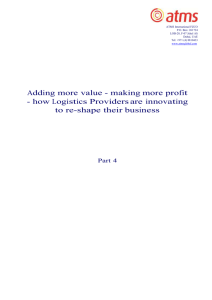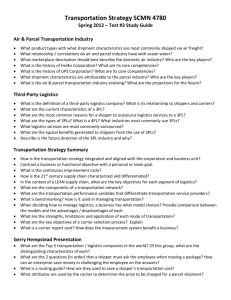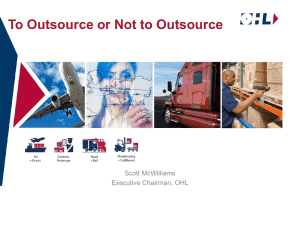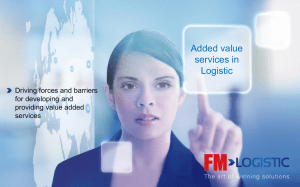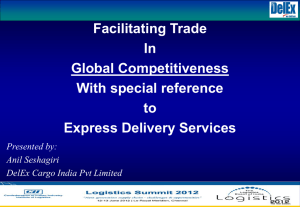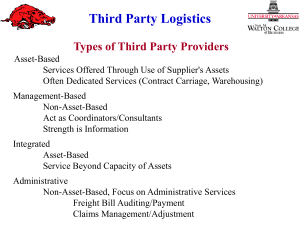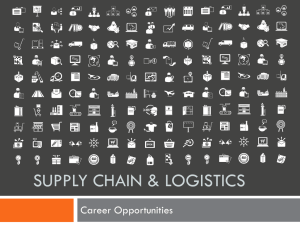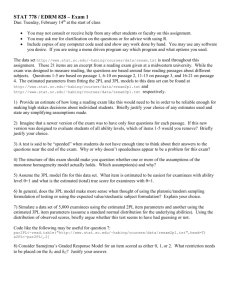Continuing to Add Ever More to Their Offerings, 3PLs Are—At Your
advertisement
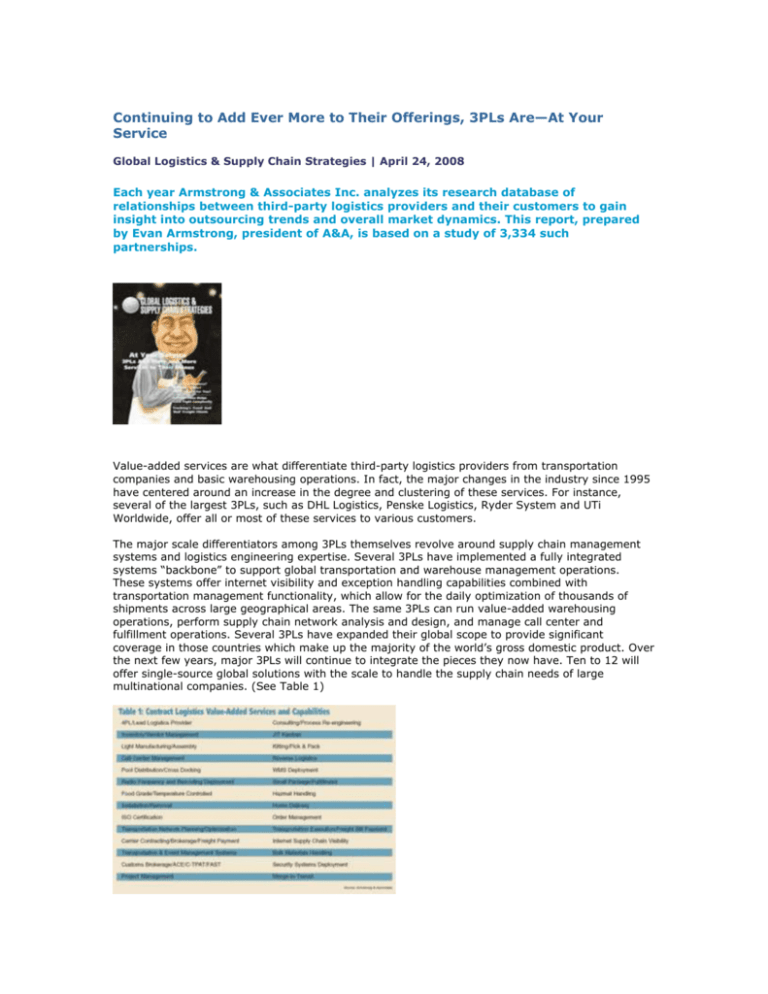
Continuing to Add Ever More to Their Offerings, 3PLs Are—At Your Service Global Logistics & Supply Chain Strategies | April 24, 2008 Each year Armstrong & Associates Inc. analyzes its research database of relationships between third-party logistics providers and their customers to gain insight into outsourcing trends and overall market dynamics. This report, prepared by Evan Armstrong, president of A&A, is based on a study of 3,334 such partnerships. Value-added services are what differentiate third-party logistics providers from transportation companies and basic warehousing operations. In fact, the major changes in the industry since 1995 have centered around an increase in the degree and clustering of these services. For instance, several of the largest 3PLs, such as DHL Logistics, Penske Logistics, Ryder System and UTi Worldwide, offer all or most of these services to various customers. The major scale differentiators among 3PLs themselves revolve around supply chain management systems and logistics engineering expertise. Several 3PLs have implemented a fully integrated systems “backbone” to support global transportation and warehouse management operations. These systems offer internet visibility and exception handling capabilities combined with transportation management functionality, which allow for the daily optimization of thousands of shipments across large geographical areas. The same 3PLs can run value-added warehousing operations, perform supply chain network analysis and design, and manage call center and fulfillment operations. Several 3PLs have expanded their global scope to provide significant coverage in those countries which make up the majority of the world’s gross domestic product. Over the next few years, major 3PLs will continue to integrate the pieces they now have. Ten to 12 will offer single-source global solutions with the scale to handle the supply chain needs of large multinational companies. (See Table 1) The size of 3PL accounts varies in net revenue from a few hundred thousand dollars to over $100m. Most major 3PLs steer away from accounts of less than $10m in purchased transportation or distribution management. Smaller accounts with transportation management needs often turn to Landstar Global Logistics, C.H. Robinson or smaller brokerage-based 3PLs, such as BNSF Logistics or Allen Lund. Smaller accounts tend to offer marginally better profitability and change their 3PLs less often. While the Armstrong & Associates database does not include every 3PL customer relationship, it is large enough to identify how and to what extent customers are using 3PL services. Table 2 lists the top Global Fortune 500 3PL customers utilizing 10 or more 3PLs within their supply chain operations. (See Table 2) General Motors ranks fifth in the Global Fortune 500 and first in overall 3PL use with 43 3PL relationships identified, and Ford Motor is second with 36 3PL relationships. CEVA, Menlo, Ryder and Penske Logistics are managing significant parts of GM’s supply chain. Wal-Mart, the world’s largest company, ranks third in 3PL use with 32 3PL relationships. DaimlerChrysler follows Ford, GM and Wal-Mart in fourth place with 31 relationships. Major 3PL contracts with Fortune 200 companies regularly exceed $50m per year. Most of these $50m-and-greater accounts are with automotive and high-tech companies. We estimate that there are 200 or more of these accounts globally. Not all Fortune 500 companies have business models that would require the services of a 3PL. We have excluded Advertising, Financial, Insurance, Real Estate and Waste. The results after the exclusions are shown in Figure 1. In 2007, 74 percent of the domestic Fortune 500 used at least one 3PL. As Figure 1 shows, company size continues to be a good predictor of 3PL use; the larger the company, the more likely it will have at least one relationship with a 3PL. We believe that some of the inter-year variation is due to changes in the mix of customer relationships being reported by 3PLs and shifts in the Fortune rankings. There is some underreporting of customer relationships in all categories. In some cases, this can be attributed to confidentiality agreements preventing 3PLs from naming customers. However, there has been a significant increase in the penetration of all Fortune companies by 3PLs since 2001. These increases are largest in groupings 401-500 and 301-400. The increase from 2001 to 2007 is smallest in the group 1-100. The overall pattern of increases in each ranking group indicates a significant trend of smaller companies outsourcing more functions to 3PLs over the last few years. Use of 3PLs has doubled since 2001 in the 301-400 group and gone up 254 percent in the 401-500 group. As we pointed out in previous reports, two primary sales strategies have emerged. DHL Logistics, Menlo Worldwide, Penske Logistics, Ryder and other well-known major 3PLs emphasize selling to the top 200 to 250 Fortune companies. Other companies like C.H. Robinson and Landstar Global Logistics are more inclined to pursue smaller accounts offering the potential for longer relationships with better profit margins. The awareness among Fortune 101-1000 companies of the benefits of using 3PLs is continuing to grow and this growth should hold over the next five or more years. For their part, 3PLs continue to develop business opportunities at three to four times the rate of growth in the U.S. GDP. We estimate that the overall U.S. 3PL market will expand 7.5 percent, +/- 1.5 percent, in 2008. The increased 3PL usage described above is consistent with information from A&A’s other ongoing 3PL market research. We estimate 3PL penetration of the total potential U.S. 3PL market is 16 percent, up from 10 percent in 2002. Consistent with this figure is A&A’s estimate of total U.S. 3PL revenues increasing from $65.3bn in 2001 to $122bn in 2007. A&A’s estimate of the 2006 3PL revenues from the Global Fortune 500 is $162.4bn. These companies account for 38.9 percent of the $417.1bn global 3PL market. This estimate is subject to our North American definitions and orientation to third-party logistics. That is, we define segments as domestic transportation management, international transportation management, dedicated contract carriage (DCC) and value-added warehousing/distribution (VAWD). The first two categories are non-asset based; the latter two are traditionally asset-based. Our definitions grew out of the regulatory framework for transportation and warehousing in the U.S. Our European colleagues tend to lump the VAWD and outbound transportation into “contract logistics.” To the degree that third-party logistics is developing in Asia, the separate segments are more likely to be lumped under the term supply chain management and tend to be focused on international transportation management (freight forwarding and NVOCC). A&A’s estimates of the total logistics costs and corresponding 3PL revenues for the Fortune 500 Global companies and by industry vertical are shown in the table below. (See Table 3) Figure 2 provides a breakout of A&A’s 3PL revenue estimates for the Fortune 500 global companies. In reviewing Figure 2, it is important to remember that these categories are broad. For example, “Technological” includes aerospace and defense companies. We include some information on the various sub-segments within the major industry segments in the following paragraphs. The largest industry segment is “Automotive” of which $38.9bn of the 3PL spend is from the “Motor Vehicles and Parts companies” sub-segment. General Motors, Ford Motor, DaimlerChrysler, Volkswagen, BMW and Toyota Motor have 43, 36, 31, 30, 21, and 19 reported 3PL relationships, respectively. Accounting for $37.6bn of the estimated 3PL spend is the more varied “Technological” industry segment. It encompasses companies in eight different sub-segments. The largest sub-segment of “Electronics, Electrical Equipment” companies accounts for 44.7 percent of total Technological segment revenues with an estimated 3PL spend of $16.8bn. Companies in this segment include Siemens, Royal Philips Electronics, Sony, Samsung Electronics and LG with 18, 15, 14, 11, and 10 respective 3PL relationships. The next largest sub-segment is “Computers, Office Equipment” with $8.1bn of 3PL spend. “Retailing” is the third-largest 3PL revenue segment for the Fortune 500 Global. It has total 3PL revenues of $25.5bn. Retailing segments into “General Merchandisers” such as Wal-Mart, Sears, Target, J.C. Penney, and Marks & Spencer accounting for $13.2bn, or 51.8 percent, of total segment revenues and three smaller sub-segments. The “Food & Drug Stores” sub-segment includes Safeway, Kroger, Supervalu and Rite Aid. “Specialty Retailers” include Home Depot, Lowe’s, Gap and Office Depot. The fourth-largest segment for 3PL revenues within the Global Fortune 500 is “Elements” with $24.4bn. This segment is dominated by companies with core businesses in petroleum refining and account for an estimated $14.5bn of the total 3PL spend and 59.4 percent of total segment revenues. Much of the total spend from these companies is transportation related. We have 12 3PL relationships and two lead logistics provider relationships tallied for ExxonMobil, the second-ranked Fortune 500 Global company. Third-ranked Royal Dutch Shell is using 10 3PLs. Elements also includes chemical manufacturers. Notables include DuPont with 12 identified 3PL relationships and BASF with 11. A&A receives inquiries about what companies are “lumped” into the “Other” industry segment. Many of these companies are engaged in transportation services. “Mail, Package, Freight Delivery” companies such as FedEx, the U.S. Postal Service, Deutsche Post, and United Parcel Service, use 3PLs and account for $2.5bn or 27.8 percent of the segment revenues. Also, airlines, railroads and shipping lines have relationships with 3PLs to often facilitate non-core transportation activities. We show “Entertainment” companies Time Warner and Walt Disney both with five 3PL relationships and significant spends. In A&A’s Who’s Who in Logistics guides we use the functional categories shown in Figure 3. “Integrated Solutions” are combinations of other service offerings, such as dedicated contract carriage, warehousing and transportation management. “Value-Added” refers to services such as merge-in-transit, reverse logistics, packaging and a host of others that are listed in Table 1 that go beyond basic offerings. “Supply Chain Management” refers to multiple 3PL services being performed within multiple segments of a customer’s supply chain. The combination of integrated, supply chain management, and lead logistics accounts for 21 percent of the responses. This 21 percent of services has more strategic properties. Or stated another way, about 79 percent of the services offered by 3PLs are tactical. Of the 3,334 3PL customer relationships we identify, there are 10,094 individual types of services being provided by 3PLs. The primary 3PL services provided were led by transportation management (21.4 percent), warehousing (19.2 percent), and value-added services (18.7 percent). These are shown in Figure 3. The number of 3PL services provided by industry segment is shown in Table 4. On average 3 services are provided by 3PLs for each customer relationship. This has grown from 2.9 services in 2004. These increases reflect how 3PL relationships with existing customers are expanding each year. The number of services provided per contract is highest in Technological and Automotive, indicating the higher degree of differentiated, mature supply chains in these verticals. (See Table 5) The types of 3PL services utilized vary by industry segment. Table 6 details the ranking and percentage for each service. The results in Table 6 indicate that warehousing services are most important in consumer products, healthcare and high-tech industries. Transportation management is the most important 3PL service in the other industry segments. (See Table 6) A&A has analyzed supply chain manager and lead logistics provider relationships closely since 2000. The total number of SCM and LLP relationships has increased each year. The relative percentage of SCM and LLP relationships for total services has increased to 8.2 percent. As we pointed out above, these are included in the 21 percent of services of a strategic basis. Seventy-nine percent of 3PL services are still contracted on a tactical basis. While there is some slow change, most customers are still reluctant to turn over inventory control and extended supply chain management to their logistics providers. To the extent that SCM and LLP relationships have been formed, they are most likely to occur in high-tech, automotive and retail areas where relationships are partnership-based and involve larger 3PL accounts. These relationships are detailed in Table 7. Penetration of different industries by 3PLs is a good indication of their target marketing and sales efforts. For example, European providers Rudolph and Thiel and North American-based CEVA have strong automotive concentrations. Rudolph is a sophisticated automotive logistics 3PL. It continues to expand in contract logistics for auto parts vendors, high-tech and other verticals. CEVA is a major automotive 3PL. It operates in 26 countries with 1,200 contracts serving 800 customers. The CEVA operations we have visited get top marks. CEVA is very good at value-added support activities and its core services include fulfillment centers, high-velocity cross-docks, subassembly modularization, dedicated contract transportation, and network designs/redesigns. Its revenues are split roughly equally between warehouse management and transportation management. (See Table 8) Penske Logistics is a very significant domestic and international automotive supply chain manager with key customers, including BMW, DaimlerChrysler, Ford, and GM. In addition to automotive, Penske is making significant inroads with Technological industry-vertical customers. In Table 9, Wincanton and YRC Logistics lead in the number of retail relationships within the A&A database. Wincanton is a market leader in food distribution for U.K. retailers. It has expertise in chilled consolidation, multi-temperature and time-critical distribution, liquid bulk transportation, and automated warehousing. YRC Logistics has a significant amount of retail pool distribution business within the U.S. with 16 regional centers with outbound direct store delivery services and has been expanding its Chinese presence. Maersk has benefited from increased international transportation management volumes from Asia to Europe and North America. Over half of its 3PL business is warehousing and distribution; about onefifth is forwarding and consolidation. Supply chain management, airfreight forwarding and customs brokerage account for the rest. The majority of revenues are between Asia and North America. About one-third is in Asia-European traffic. The acquisition of P&O Nedlloyd by its parent A.P. Moller, added more apparel and retail capacity through Gilbert’s operations, which are primarily involved in consolidation/deconsolidation and garment-on-hanger business. Maersk Logistics is being restructured into a stand-alone business in an effort to return profitability to its parent company’s containership operation, Maersk Line. (See Table 9) To expand beyond its core North American trucking operations, Werner Enterprises has invested sizably in its dedicated contract carriage and value-added services (VAS) divisions, which tally 11 Retailing customer relationships. VAS encompasses its non-asset-based transportation management operations, freight brokerage, intermodal operations, and Werner Global Logistics. Werner’s VAS and dedicated fleet operations represent a significant portion of Werner’s ongoing growth, and Dollar General, Family Dollar Stores, Mervyn’s and Target are some of its key Retailing customers. Most people know of the BNSF railroad, but may have never heard of its Springdale, Ark.headquartered non-asset-based transportation management 3PL, BNSF Logistics. It has developed a strong presence among Retailing customers with 13 relationships. BNSFL started when the railroad acquired part of Clicklogistics in 2002. Since then, BNSFL has been growing through acquisition and now provides domestic and international transportation management services to customers. Greatwide Logistics Services is another lesser-known 3PL which has also been growing through acquisition. Its revenues are now over $1.1bn. Greatwide is a domestic transportation management and warehousing provider with significant dedicated contract carriage operations. Key Retailing customers include Nordstrom, Safeway, Supervalu, Walgreens and Wal-Mart. Another company flying under the radar, but providing some very advanced packaging and labeling services to customers, is Walton, Kentucky-based Verst Group Logistics. Its largest Retailing customer is Kroger. Technological relationships are, not surprisingly, dominated by air and small package transportation-related companies. DHL Logistics, UPS SCS and FedEx SCS have the greatest number of relationships in this segment. Kitting, pick/pack, spare/service parts order fulfillment, returns handling, and refurbishment are significant value-added 3PL services being provided to customers. These relationships are listed in the following table. (See Table 10) In addition to the large 3PLs already mentioned, there are some interesting specialists serving Technological customers that are not household names. Founded in 1996, Fort Worth, Texas-based ATC Logistics & Electronics (ATCLE) is rapidly building its 3PL brand as a high-tech repair/refurbishment and high-volume order fulfillment specialist. It is most known as the 3PL that manages all of the North American AT&T Wireless outbound order fulfillment and returns/repair work. It has revenues of $294m and has grown from its sole founding customer, AT&T Wireless, to 15 long-term contractual customers, including such Technological companies as Magellan, Nokia, Palm, Sony Ericsson, T-Mobile, TomTom and TiVo. In 2001, New Breed Logistics won a bid to distribute cell phones for Verizon Wireless on the basis of a plan it developed to consolidate eight existing distribution centers into one, merge customer orders from seven legacy order management systems to a custom-developed order and inventory management system, receive orders via the web, and fulfill direct-to-consumer and direct-to-retail outbound orders every day. In addition to the outbound fulfillment, New Breed took on the task of processing returns. It was successful in executing its plans and continues to serve Verizon Wireless and 11 other Technological customers. Profile of A&A Armstrong & Associates Inc. is a consulting firm specializing in supply chain management and 3PL market research, provider benchmarking, strategic planning, mergers and acquisitions, logistics outsourcing, centralized transportation management programs, and supply chain systems evaluation and selection. Armstrong & Associates publishes Who’s Who in North American Logistics and Supply Chain Management and Who’s Who in International Logistics and Supply Chain Management. Recent research papers include “Warehousing in North America—2007 Market Size, Major 3PLs, Benchmarking Prices and Practices” and “U.S. and Global—3PL Financial and Acquisition Results—2007.” For more information: 800-525-3915 or www.3PLogistics.com
